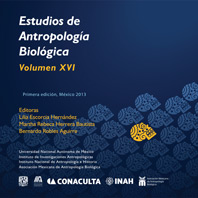Variación del adn mitocondrial en población indígena mexicana del estado de Puebla
DOI:
https://doi.org/10.22201/iia.14055066p.2013.56710Palabras clave:
adn mitocondrial, haplogrupos mitocondriales, genética de poblacionesResumen
El adn mitocondrial (adnmt) ha sido ampliamente utilizado como marcador genético en estudios de filogenia y evolución humana. Su modo de herencia uniparental permite trazar la divergencia de los linajes maternos entre poblaciones, así como las rutas de dispersión geográfica. La datación de estos sucesos se hace posible con el conocimiento de su tasa de mutación. Las variantes contenidas dentro de este genoma se pueden agrupar, identificando la ocurrencia de mutaciones diagnósticas, en lo que se denomina haplogrupos. En América son cinco los haplogrupos que representan la diversidad de nuestras poblaciones nativas (A, B, C, D y X). En este estudio analizamos secuencias de la región hipervariable I de 50 individuos provenientes de dos comunidades indígenas: totonaca y nahua de la sierra Norte de Puebla. Las frecuencias de sus haplogrupos mitocondriales concuerdan con las reportadas anteriormente en las que el haplogrupo A2 es el más frecuente (.74), seguido del haplogrupo B2 (.20); únicamente en la población totonaca se encuentra el haplogrupo D, pero con muy baja frecuencia. En el grupo nahua hay una mayor diversidad haplotípica que puede deberse a la integración de nuevas variantes en los procesos de mestizaje de este grupo durante el periodo de expansión del imperio mexica. En la población totonaca se observa una mayor cantidad de sitios polimórficos, lo cual apoya los datos históricos que presentan a esta población como originaria en la región; la mayor representación de individuos totonacas en el nodo ancestral de la red del haplogrupo A2 apoyaría esta propuesta.
Descargas
Descargas
Publicado
Cómo citar
Número
Sección
Licencia

http://creativecommons.org/licenses/by-nc-nd/4.0/


